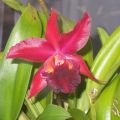


Donate Now
and become
Forum Supporter.

Many perks!
<...more...>


|

04-09-2008, 08:00 AM
|
 |
Senior Member
|
|
Join Date: Apr 2006
Zone: 9a
Location: Spring Hill, FL
Posts: 17,222
|
|
 Definition of a species
Definition of a species
I found this while cruising the 'net this morning. It's very detailed but does explain just what a "species" is:
What is a species? |

04-09-2008, 08:44 AM
|
 |
Senior Member
|
|
Join Date: May 2005
Location: Oak Island NC
Posts: 15,388
|
|
In my opinion, it's a long-winded explanation that doesn't really define it well. A bunch of plants that look alike? Gee - a whole bench of Phalaenopsis Baldan's Kaleidescope sure look alike!
I agree that it is a tough thing to define, but I would bet that having some unique genetics that interbreed true will be part of it.
|

04-09-2008, 08:45 AM
|
 |
Senior Member
|
|
Join Date: Apr 2006
Zone: 9a
Location: Spring Hill, FL
Posts: 17,222
|
|
I agree, it's easier to get a human to explain it but figured I'd put this information out there for those who are interested  |

04-09-2008, 10:24 AM
|
|
Senior Member
|
|
Join Date: Feb 2007
Location: Winchester, UK
Posts: 2,993
|
|
Sue, Good reference for an introduction to the concept. Here is the reference I normally use:
Evolution -- What is a Species and What is Not |

04-09-2008, 10:28 AM
|
 |
Moderator
|
|
Join Date: May 2005
Zone: 7b
Location: Queens, NY, & Madison County NC, US
Age: 45
Posts: 19,374
|
|

It looks like a good attempt. However they did make a mistake. When writing out a species name, for example
Paphiopedilum rothschildianum you do not underline between the two names. It would be Paphiopedilum rothschildianum or Paphiopedilum rothschildianum.
He also fails to teach about the system of classification. He starts to but doesn't finish.
The system is made up of Kingdom, Phyllum, Class, Order, Family, Genus, Species (my students never get this wrong either because they know Im gonna drill them on it, or because I give them an easy way to remember it, King Philips Class Out For Good Sex).
All plants are in the kingdom Plantea, all plants that can transport water using vessels so they can grow tall and live away from water and give fruit with seeds are in the Division Anthophyta. Division used instead of phyllum here (so it would be King David's Class) These are all the flowering plants, different from plants like Ginko or Pines, Junipers, (all in one division), different from ferns and their allies, and different from mosses and liverworts.
Then you class, orchids are in the class Liliopsida because they are monocots, like grasses and peace lillies, jack in the pulpits, dragon trees, and lilies etc.
Then you have order Asperagales, which includes orchids and irisis for example.
Then you go on to family, where we have all plants that are orchids, Orchidaceae. Then you get down to the genus, Paphiopedilum whose sister genera include all lady slipper genera, Cyps, Phrags, Mexi's, and Selenepidiums as well (the 5 genera are grouped into a tribe, a level between family and genus). Then you get down to the species level. P. rothschildianum.
Look how they do it here: Paphiopedilum rothschildianum - Wikipedia, the free encyclopedia
__________________
"We must not look at goblin men,
We must not buy their fruits:
Who knows upon what soil they fed
Their hungry thirsty roots?"
Goblin Market
by Christina Georgina Rossetti
Last edited by Tindomul; 04-09-2008 at 10:37 AM..
|
|
Currently Active Users Viewing This Thread: 1 (0 members and 1 guests)
|
|
|
 Posting Rules
Posting Rules
|
You may not post new threads
You may not post replies
You may not post attachments
You may not edit your posts
HTML code is Off
|
|
|
All times are GMT -4. The time now is 12:54 PM.
|
































 Linear Mode
Linear Mode


